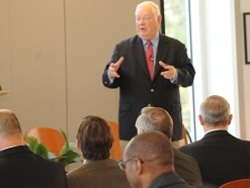


The purpose of any training program is to deliver results. People must be more effective after the training than they were before. If change hasn't taken place that benefits the individual and the organization, I'm not really sure that training has been delivered.
Three years after my training career began, I had developed a variety of training programs. I learned to break people into groups and to give them hands-on opportunities, yet I continued to rely upon a lecture format.
That changed in 1973 when I traveled to Minneapolis to evaluate a seminar I was considering adding to my business.
The first day, 30 of us gathered in a room and were seated in groups of five. The instructor made a few brief introductory remarks and then passed out written materials for each group to discuss. After each group summarized its discussions, we moved onto the next activity. When it was time for a lecture, the instructor would play an audiotape. By noon, I was still waiting for him to say something so I could evaluate the quality of the program. I kept waiting. I decided that if my investment were to be worth something, it was going to be because of me. Finally, on the third day, I realized I could recall almost all our discussions and activities because I was involved. I had made some significant discoveries and decisions—and I had truly learned—because I had truly participated.
What makes the Creating Training Technique's Instructional Model so different from most other classroom delivery processes? One major difference is that we emphasize the power of group dynamics. Our research strongly suggests that more than 75 percent of all learners prefer to learn as part of a group, rather than by themselves. Learning is a social experience. Yet, all too often, we see classrooms where people sit in rows facing the instructor.
Instructors normally voice two objections to using the CTT participant-centered process:
When we use the CTT process, we can reduce the time it takes for participants to master content. This first objection also has as an underlying assumption that covering the content is the goal. When teaching the content becomes the goal, most instructors settle on the fact that by focusing on the Need to Knows and giving participants adequate time to process those Need to Knows, they actually end up teaching more by covering less.
As for the second objection, the instructor doesn't lose control. Rather responsibility for control passes from the instructor to a group leader. Chaos doesn't reign; learning does. I am fostering an illusion when I believe I am in control just because students are quietly sitting and looking at me during my presentation. They could mentally be sitting in a chaise lounge in Bermuda and I'd never know it!
By using classroom management techniques, you will maximize the involvement of every participant, reduce difficult participant behavior, increase the self-esteem of participants, and maximize your focus on insuring participant's understanding and mastery of skills and knowledge by shifting responsibility for control from you to the participants as a group.
Adapted from Creative Training Techniques Handbook, Third Edition
The Bob Pike Group offers a Professional Trainer Certification program which includes Classroom Management Techniques, dealing with difficult participants, and more Creative Training Techniques. For more information on the trainer certification click here.




3740 N Chestnut St #113 - Chaska, MN 55318-3053